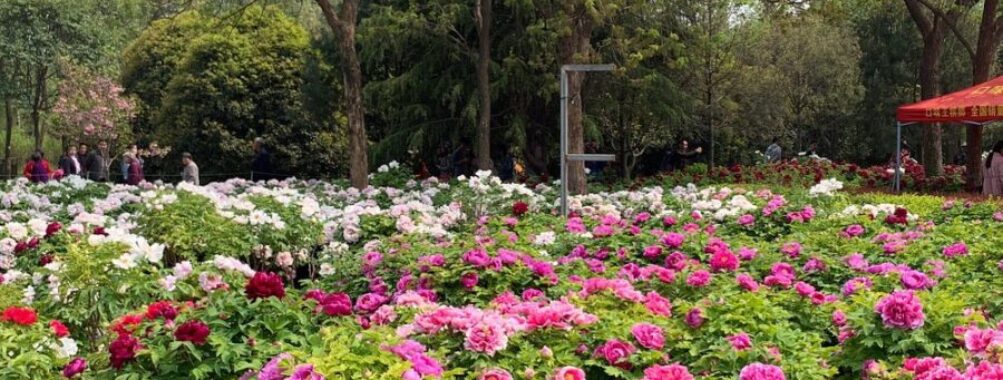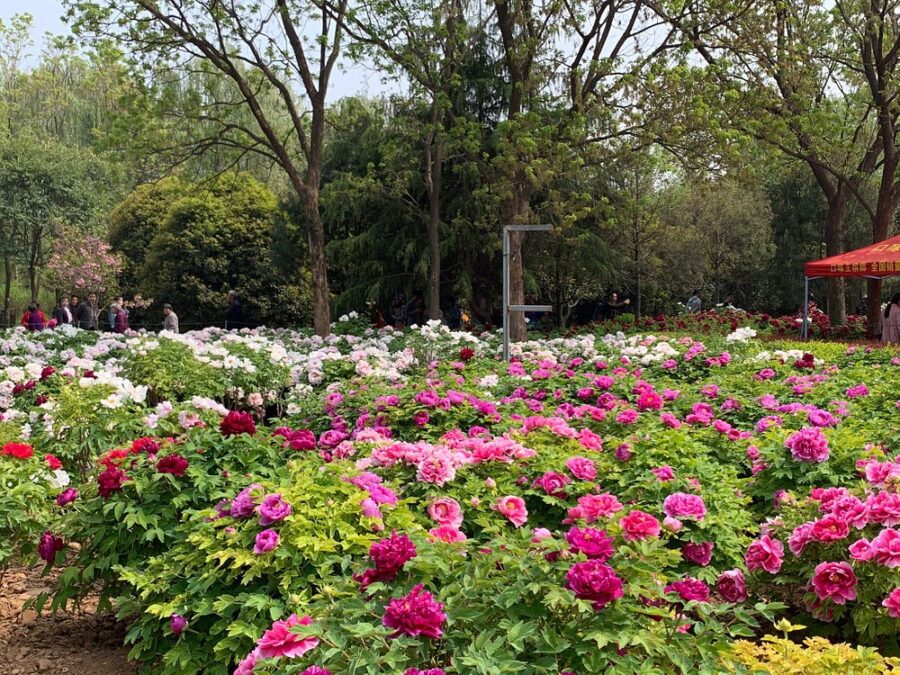
China National Flower Garden (East Gate)
Table of Contents
History and Significance

If you find yourself in Luoyang, a city steeped in ancient Chinese culture and history, the China National Flower Garden (East Gate) is a place you’ll want to visit to truly appreciate the floral heritage of the region, especially the grandeur of the peony. Established in 2001 along the southern bank of the Luo River, this garden spans an impressive 255 acres, making it the largest peony park in China. It is widely celebrated as the “No. 1 Garden of China’s National Flower.”
The garden’s significance arises not only from its breathtaking flower displays but also from its integration of ancient Chinese cultural elements, particularly from the Sui and Tang Dynasties (581–907 AD)—periods when Luoyang was a thriving imperial capital. The garden thoughtfully combines traditional royal garden artistry with the rich symbolism and history of the peony, often called “The King of Flowers” and seen as a symbol of wealth, prosperity, and honor in Chinese culture.
The China National Flower Garden stands as a living testament to centuries of horticultural excellence, artistic beauty, and cultural reverence. It preserves and promotes the rich traditions of flower appreciation, poetic inspiration, and garden design deeply embedded in Chinese history, making it a cultural as well as a natural treasure.
Main Attractions and Activities
When you step through the East Gate, you enter a captivating floral landscape that invites endless exploration:
-
Peony Flower Collection: The garden is home to around 1,000 varieties of peonies with over 500,000 individual plants. These range from delicate shades of white to deep, vibrant reds, each variety bursting with unique forms and historic names. During the peak bloom season (April to early May), the peonies transform the garden into a sea of color and fragrance, a dreamlike spectacle.
-
Flower Photography Zones: Carefully designed photo frames and viewing platforms line the pathways, offering perfect spots to capture the floral majesty. These frames, sponsored by local companies, spotlight the blossoms poetically.
-
Firing Peony Area: Legend weaves through the “Firing Peony” section, said to have origins in Taoist lore involving Taishang Laojun and golden elixirs causing magical growth. The thematic presentation combines botanical wonder with mythological storytelling.
-
Jinshi Text Museum: Near the East Gate, this modern pavilion, built in 2012, features an extensive collection of ancient calligraphy and texts related to flowers and garden culture. It provides academic depth and refinement to the garden visit.
-
Kaiyuan Fugui Square: Named in tribute to the Tang Xuanzong era—considered a golden age of Chinese culture—this relaxing plaza within the garden features classical pavilions and resting spots, blending art, leisure, and history.
-
Lakes, Hills, and Rock Formations: Beyond flowers, the garden’s design includes elegant lakes, tranquil hills, and artificial rockeries, creating a harmonious landscape that echoes traditional Chinese garden aesthetics.
-
Seasonal Events: Throughout spring and early summer, the garden hosts flower festivals, cultural performances, and guided tours that deepen visitor engagement.
Visitor Experience
Visiting the East Gate of China National Flower Garden feels like stepping into a vibrant painting, filled with color and history. The perfumed air of blooming peonies mingles with the peaceful rustling of leaves, transporting you into a serene yet majestic space.
I recall a family trip there during the height of peony season. We wandered among grand blossoms so large and lush you could almost hear them breathing. Children ran between flower beds, while elderly couples admired the intricate patterns and fragrant air with contented smiles. The garden’s thoughtful layout allows for both energetic exploration and quiet contemplation.
The juxtaposition of blooming flowers with classical pavilions, placid lakes, and ancient stone lanterns left a lasting impression—the garden was a harmonious blend of nature and culture, inviting visitors to rest, reflect, or celebrate.
Photographers, nature lovers, historians, and casual visitors all find moments of wonder here. The combination of floral splendor and rich cultural storytelling truly makes the experience special.
Tips for Visitors
To make your experience at China National Flower Garden smooth and memorable:
-
Visit between late April and early May for the peak peony bloom season.
-
Arrive early in the day to enjoy cooler temperatures and more serene surroundings.
-
Wear comfortable walking shoes for the sprawling grounds.
-
Bring water and sun protection, as many areas are open and exposed.
-
Use the map or guided tours to navigate the extensive garden and not miss highlights.
-
Try capturing photos from designated photo frames for iconic shots.
-
Combine your visit with other Luoyang attractions, such as the Longmen Grottoes or the Luoyang Museum.
-
Public transport and taxis are reliable ways to reach the East Gate; parking may be limited during peak season.
-
Visit the Jinshi Text Museum for an enriching interlude of literary and cultural context.
Accessibility and Facilities
The China National Flower Garden offers good accessibility and visitor amenities:
-
Smooth paved paths and gentle slopes make most areas wheelchair and stroller accessible.
-
Rest areas with benches and shaded pavilions are plentiful throughout the park.
-
Reliable signage in Chinese and some English guides ensures ease of navigation.
-
Clean and well-maintained public restrooms are available near major entrances.
-
Cafeterias and snack kiosks provide refreshments during peak visitor periods.
-
Staff and security personnel maintain order and visitor safety.
-
Visitors are encouraged to respect garden rules, preserving serenity and floral health.
Unique Features
What distinguishes the China National Flower Garden East Gate and the whole park?
-
Largest and finest peony collection in China, showcasing unparalleled varieties and cultivars.
-
Addressing the Sui and Tang dynasty cultural heritage, with gardens styled to reflect the grand Chinese imperial aesthetics.
-
The integration of flower folklore and Taoist legends into thematic sections gives the garden narrative richness.
-
The adjacent Jinshi Text Museum, which deepens the cultural engagement with ancient literary works related to botany and gardens.
-
The blending of natural elements such as lakes, hills, and rock formations reflects classical Chinese garden design principles.
-
It plays the role of a cultural hub, hosting seasonal events and flower festivals, drawing locals and tourists alike for celebratory occasions.
Overall Impressions
Honestly, the China National Flower Garden (East Gate) delights as a feast for the senses and the soul. Walk through its paths and you’re embraced by the grandeur of blooming peonies, each flower seemingly steeped in history and poetic symbolism.
The garden’s careful landscaping creates moments of peace and grandeur—in which nature, mythology, and art mix effortlessly. It offers a meaningful respite from urban bustle and a chance to reconnect with one of the world’s oldest and most refined horticultural traditions.
Whether you are a passionate botanist, a culture lover, or just someone craving breathtaking floral beauty, this garden wrapped in imperial history invites you to linger, explore, and celebrate Chinese heritage in full bloom.
Pros and Cons
| Pros | Cons |
|---|---|
| China’s largest and most comprehensive peony collection | Peak season crowds can be significant during bloom months |
| Rich cultural and historical integration with garden design | Limited English signage compared to some major tourist spots |
| Beautiful landscaping with lakes, hills, and rock gardens | Cafeteria and refreshment options are limited |
| Jinshi Text Museum adds unique literary and cultural depth | Parking space is limited during festivals |
| Serene and spacious environment, good for families and photographers | Some parts of the garden require considerable walking |
| Seasonal festivals and cultural events enrich the experience | Weather-dependent bloom spectacle; best timing essential |
Location
Places to Stay Near China National Flower Garden (East Gate)
Find and Book a Tour
Explore More Travel Guides
No reviews found! Be the first to review!